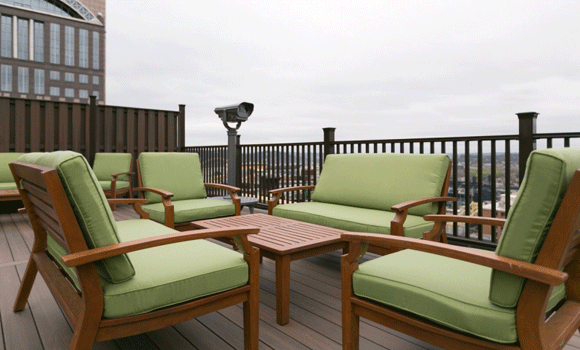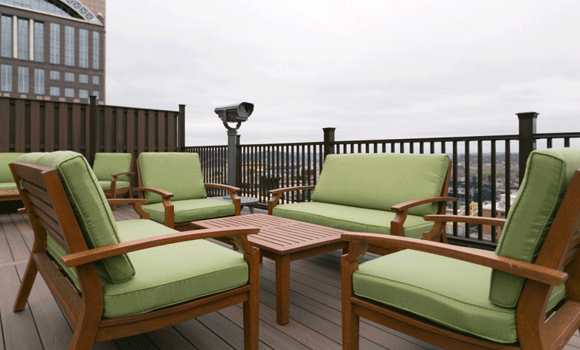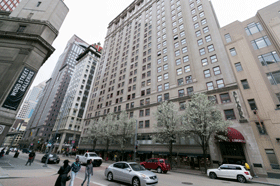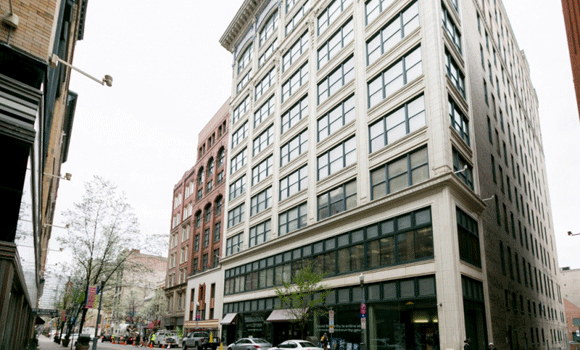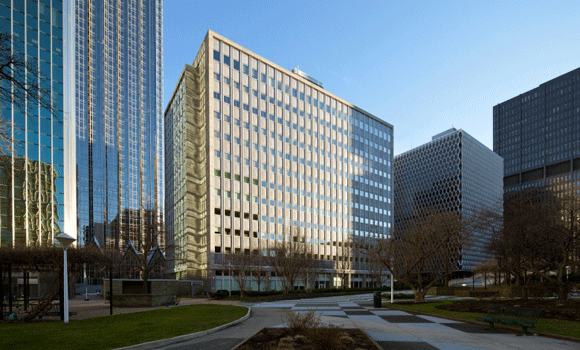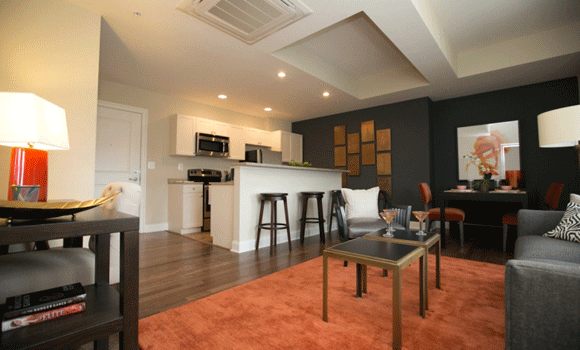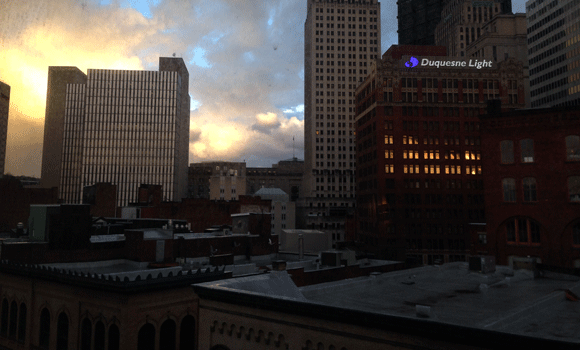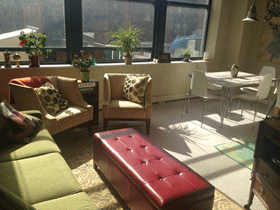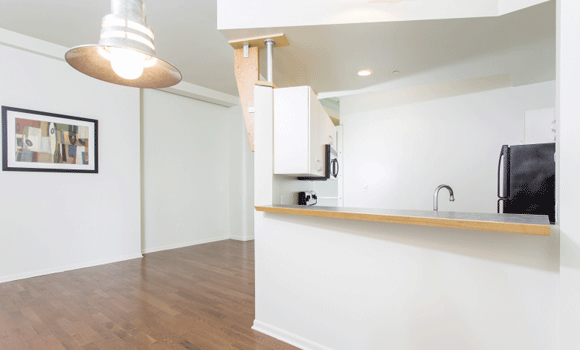Hilary Brown is not new to Pittsburgh. Outside of a five-year stint in Boston, it’s been her home for her entire life. Until March of last year, Brown owned a cozy home in Dormont, but an opportunity to sell her house inspired her to try something different.
“I work Downtown and just love how it's been transforming over the years,” says Brown. “It has a great energy and I was excited about the quality of life it offered.”
Moving Downtown did mean downsizing, but Brown did so happily.
“I realized that I didn't want to spend my weekends landscaping, gardening, fixing things and cleaning,” she adds.
Instead, she looked forward to taking in more cultural opportunities and spending more time at her favorite restaurant, including Butcher and the Rye, Meat and Potatoes and Sonoma.
After an exhaustive search, Brown chose the Penn Garrison Lofts at 915 Penn Avenue for two reasons: the view and the location.
“I was determined that, if I were to live Downtown, I wanted a great city view,” she enthuses. “This apartment has it all in that regard. There are views of big beautiful skyscrapers, alleyways and murals, as well as rooftops and gritty fire escapes. And, it's located in the heart of the Cultural District, so everything is right outside my door.”
Her 10-minute commute is the cherry on top.
“There has been maybe one day that I didn't love my walk to work,” insists Brown. “Most of the time I feel very Mary Tyler Moore.”
A former ghost town
If you haven’t spent much time in Pittsburgh, it’s easy to take today’s vibrant, thriving, livable Downtown for granted. But it hasn’t always been this way. Even a decade ago, the bustling epicenter of Steel City turned into a ghost town shortly after business came to a close each night. Hardly anyone lived Downtown because there was hardly anywhere to live Downtown. And with porn shops, strip joints and sleazy bars still making up most of the post-happy hour atmosphere, it really wasn’t all that appealing.
So what changed? Well for one thing, the Pittsburgh Downtown Partnership (PDP) came into existence.
“The PDP came together with the city in the late ‘90s to develop a strategy to encourage developers to begin to consider what was believed to be untapped potential to redevelop some of the existing office space into residential properties,” says Vice President of Marketing Leigh White. “This task force was comprised of a variety of members and organizations [who] worked together to lay the groundwork for the exciting development that has already occurred and is currently underway.”
According to the PDP’s State of Downtown Pittsburgh Report for 2014, 47.5 percent of all residential units in Greater Downtown Pittsburgh, which includes the Golden Triangle as well as Bluff, North Shore, South Shore and the Strip District, were built after 2000.
If it weren’t for the early vision and constant vigilance of organizations like PDP as well as the Pittsburgh Cultural Trust, Downtown might still be an undesirable red-light district instead of one of the country’s most livable cultural ones.
Back in the ‘90s, the PDP had a full-time staff person dedicated to courting developers for Downtown Pittsburgh. But as White explains, “It’s been 7 to 8 years since that was a position. The market clearly doesn’t need the assistance of our organization anymore.”
A residential renaissance
Between 2000 to 2010, 1,293 units were added to greater Downtown, and in just the past three years an additional 1,340 units were added (PDP, 2014).
According to White, the trend has been about repurposing rather than building new construction. Development projects big and small have transformed outdated offices and unused commercial space into swanky loft apartments filled with character. Since 2011, about two million square feet of office space has been removed from the market as the buildings undergo conversion to hotel and residential uses. (PDP, 2014)
A major contributor to this movement continues to be PMC Property Group, an urban development company based out of Philadelphia, but with offices here in Pittsburgh. PMC’s first project Downtown was the renovation of 201 Stanwix, completed in 2011. Built in 1957, the building was originally used as office space by Bell Telephone of Pennsylvania and later by Verizon. While PMC was able to preserve some of the historical features — including wood paneling, built-in bookcases and wet bars — the renovation required a near-total gut. The building, which is listed on the National Register of Historic Places, now houses 158 one- and two-bedroom apartments, as well as a charter high school on the lower floors.
For PMC, repurposing old buildings is not a trend, but rather, “our niche,” insists Senior Vice President Louise Giordano.
Most recently, PMC completed renovations of The Clark Building at 717 Liberty Avenue. The historic building once served as a film screening space for MGM and now boasts 228 residential units.
The Lando Lofts at 909 Penn Avenue are another great example of this reuse philosophy, but on a smaller scale. According to White, every one of the 28 units is unique; some offer exposed brick walls with original hand-painted advertising signs.
In addition to urban yet posh interiors with expansive windows and high ceilings, stainless steel appliances and granite countertops, many Downtown apartments also offer incredible amenities. Take Brown’s building, for instance.
“We have a great gym and a dry cleaning service that I use regularly,” she says. “There is also an amazing rooftop deck that overlooks the river and stadiums. I have people over to watch the fireworks quite a bit or just enjoy dinner and drinks.”
The nearby Lando Lofts even offer room service for their tenants.
But luxury comes with a price. According to the 2014 PDP Report, the average price of a one-bedroom Downtown rental is just shy of $1,500 per month and the average condo sale price was just over $320,000.
If you build it, they will come
The PDP estimates that the opening of 824 units in Greater Downtown attracted 1,176 new residents between 2010 and 2013. When asked if development is starting to slow down, White says there’s not a chance.
“The proposed construction for the next 5 to 7 years is almost double what it was previously,” he says. “These are smart developers who we agree with and they have an interest and desire to keep going. There is a big move to connect strong residential areas [Lower Hill, Strip District, Station Square] with the Golden Triangle to create more cohesive overall neighborhood plans.”
Despite this nonstop development, average occupancy rates continue to stay above 95 percent and demand is coming from both ends of the spectrum.
“We’re definitely seeing younger Millennials, but we also have a lot of empty nesters interested in accessing everything Downtown has to offer,” adds White. “It’s just an incredibly easy place to live.”
Giordano echoes this point, explaining that many young people are transitioning from the dorms at Point Park University into PMC properties.
PMC continues work on 220 units at the Regional Enterprise Tower, which Giordano says should begin leasing in the spring. The company will then focus its efforts on North Oakland, transforming the former Schenley High School building, acquired in 2013, into 175 residential units.
According to the PDP, work also continues on 41 units at Aria Cultural District Lofts on Seventh Street; an additional 2,229 units are proposed for the Greater Downtown area over the next few years.
Potential projects within the Golden Triangle include 200 units at the Cultural Trust site, 100 units at 200 Ross Street, 34 units at 711 Penn Avenue, 30 units at 422 First Avenue, and 30 units at 819-823 Penn Avenue. (PDP, 2014)
White points out that many things are happening simultaneously to help support all this development. New restaurants and bars are popping up regularly. Dedicated bike lanes now make it safer and easier for residents to get around on two wheels. And a long-awaited grocery store will open in Market Square this February.
When asked what the city still needs to support the growing community of residents, Giordano, who lives Downtown herself, didn’t hesitate”
“Parking. People in Pittsburgh just aren’t ready to give up their cars here like they do in other cities.”
White agrees that the parking issue needs to be addressed. And when asked if she lives Downtown, she exclaimed, “I don’t, but I really wish I did! Some nights there is just so much going on I really don’t want to go home.”
